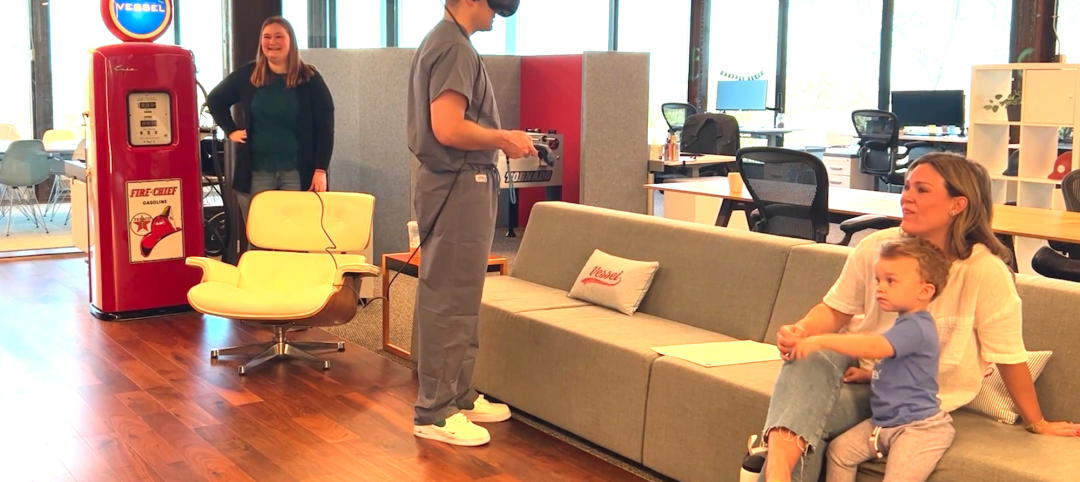The relationships between buildings and machines have always defined the fields of design and construction. More than 2,000 years ago, in the first treatise on architecture, Vitruvius dedicated all of the final volume to machines. Since then, arguably the entire history of construction has centered on the movement away from handicraft toward progressive degrees of mechanization. Today, mechanization, the replacement of hand labor, is increasingly giving way to automation, the replacement of human labor altogether.
Below are four fundamental relationships between buildings and machines. As automation becomes more prominent, it is changing these relationships dramatically.
Machines in Buildings
Over the past century or two, new mechanisms have fundamentally redefined the possibilities of buildings. After Elisha Otis invented the safety elevator in 1852, buildings could climb well beyond a comfortable walk-up height, and the skyscraper was born.
In 1902, Willis Carrier introduced modern air conditioning, which allowed floor plates to get deeper (spurring a century of energy hogging). The bimetallic thermostat, an example of automation dating from the 1880s, long has been a staple in homes and offices everywhere. Building automation systems (BAS) apply this concept systemwide, with internal feedback adjusting HVAC and lighting to improve comfort, security, energy consumption, maintenance, and operating costs.
The Internet of Things (IoT) connects computers embedded in everyday objects, including buildings, to expand these feedback loops beyond the immediate building to the entire world. Over the next few years alone, instances of IoT are expected to double in commercial real estate. Buildings are coming to be defined less as static objects and more as completely fluid environments.
Machines for Building
Ancient structures were assembled with a few simple tools, and the oldest may have used none at all. Possibly the earliest known “constructions,” during the Stone Age, were made of Mammoth bones lashed together to form huts. With the agricultural revolution, communities became less nomadic, and buildings became less portable, leading to heavier construction and the need for more powerful tools.
The industrial revolution catapulted whole industries and economies with mass-produced timber and steel. The history of construction since then has been propelled by leveraging more and more force, and today gigantic machines for digging and lifting dominate large construction sites.
But emerging automated techniques could return building fabrication to its origins in lightweight assembly methods. Homes are being 3D printed in 24 hours at a fraction of the expense of traditional construction. Bricklaying robots can assemble a wall at half the cost and 3-5 times the productivity. Soon, clouds of flying assembler drones could become the norm, making construction sites buzz and thrum like beehives or ant hills.
Buildings as Machines
“A house is a machine for living in,” Le Corbusier famously declared in 1929, and the mechanical metaphor became a foundational premise of modern architecture. Later, the machine aesthetic became more explicit. The Centre Pompidou in Paris (1977) wore its systems on its sleeve, the primary architectural expression coming from equipment, ductwork, and conveying systems.
But metaphor could soon become reality. Nanotechnology, originally proposed by Nobel physicist Richard Feynman half a century ago, manipulates individual atoms and molecules to build things—anything. Already, researchers have successfully experimented with nanotech in concrete and steel, strengthening materials and improving performance by adjusting automatically to offset stress and strain.
‘Buildings are coming to be defined less as static objects and more as
completely fluid environments.’ — Lance Hosey, FAIA, LEED Fellow, Gensler
Experts anticipate that within the next few decades, whole buildings could be fabricated using microscopic robots, which would join to make a cybernetic glue, eliminating traditional material constraints. Standard, irreducible components, such as the 2x4, the brick, and steel shapes, could be replaced by microscopic parts, and form, texture, color, and strength could be defined at the cellular level.
Orthogonal geometry, demanded for efficiency by standard frame construction, could disappear altogether. A century ago, Frank Lloyd Wright described “organic architecture” as “building the way nature builds.” Nanotech could finally bring this to fruition.
By modifying themselves over successive generations, ebbing and flowing in endless cycles of reproduction and adaptation, nano-assemblers could produce architecture through a process similar to genetic evolution—only faster—and therefore build exactly the way nature builds.
Buildings by and for Machines
In previous articles in this series, we’ve explored the implications of artificial intelligence. Futurist Ray Kurzweil predicts that machines will achieve human-level intelligence within a decade, and this will affect every industry, including our own.
If and when AI drives the entire process of design, construction, and operation, buildings could become exponentially smarter with resources, money, time, and performance, creating environments more engaging and comforting than we can imagine right now.
Yet, Kurzweil also anticipates that within a century we will concede that machines have legal and civil rights. Will self-aware buildings become as privileged as their inhabitants? How will our relationship with buildings change if we begin to see them as our equals? Machines could become more like us, but we could become more like them, as well.
Kurzweil is certain that artificial enhancements of the human body will become more common until we are more synthetic than organic. It will become possible to scan the mind and download it into more durable or flexible containers—such as buildings. Dwelling and dweller could become one and the same.
Lance Hosey, FAIA, LEED Fellow, is a Design Director with Gensler. His book, The Shape of Green: Aesthetics, Ecology, and Design, has been an Amazon #1 bestseller in the Sustainability & Green Design category.
Related Stories
Building Owners | Aug 23, 2023
Charles Pankow Foundation releases free project delivery selection tool for building owners, developers, and project teams
Building owners and project teams can use the new Building Owner Assessment Tool (BOAT) to better understand how an owner's decision-making profile impacts outcomes for different project delivery methods.
Transportation & Parking Facilities | Aug 23, 2023
California parking garage features wind-activated moving mural
A massive, colorful, moving mural creatively conceals a newly opened parking garage for a global technology company in Mountain View, Calif.
Digital Twin | Jul 31, 2023
Creating the foundation for a Digital Twin
Aligning the BIM model with the owner’s asset management system is the crucial first step in creating a Digital Twin. By following these guidelines, organizations can harness the power of Digital Twins to optimize facility management, maintenance planning, and decision-making throughout the building’s lifecycle.
Designers | Jul 25, 2023
The latest 'five in focus' healthcare interior design trends
HMC Architects’ Five in Focus blog series explores the latest trends, ideas, and innovations shaping the future of healthcare design.
Digital Twin | Jul 17, 2023
Unlocking the power of digital twins: Maximizing success with OKRs
To effectively capitalize on digital twin technology, owners can align their efforts using objectives and key results (OKRs).
Standards | Jun 26, 2023
New Wi-Fi standard boosts indoor navigation, tracking accuracy in buildings
The recently released Wi-Fi standard, IEEE 802.11az enables more refined and accurate indoor location capabilities. As technology manufacturers incorporate the new standard in various devices, it will enable buildings, including malls, arenas, and stadiums, to provide new wayfinding and tracking features.
Virtual Reality | Jun 16, 2023
Can a VR-enabled AEC Firm transform building projects?
With the aid of virtual reality and 3D visualization technologies, designers, consultants, and their clients can envision a place as though the project were in a later stage.
AEC Innovators | Jun 15, 2023
Rogers-O'Brien Construction pilots wearables to reduce heat-related injuries on jobsites
Rogers-O'Brien Construction (RO) has launched a pilot program utilizing SafeGuard, a safety-as-a-service platform for real-time health and safety risk assessment. Non-invasive wearables connected to SafeGuard continuously monitor personnel to prevent heat exhaustion on jobsites, reducing the risk of related injuries. RO is the first general contractor to pilot this program.
Contractors | May 26, 2023
Enhanced use of data is crucial for improving construction job site safety
Executives with major construction companies say new digital tools are allowing them to use data more effectively to reduce serious safety incidents and improve job site safety.
AEC Tech Innovation | May 12, 2023
Meet Diverge, Hensel Phelps' new ConTech investment company
Thai Nguyen, Director of Innovation with Hensel Phelps, discusses the construction giant's new startup investment platform, Diverge.

















